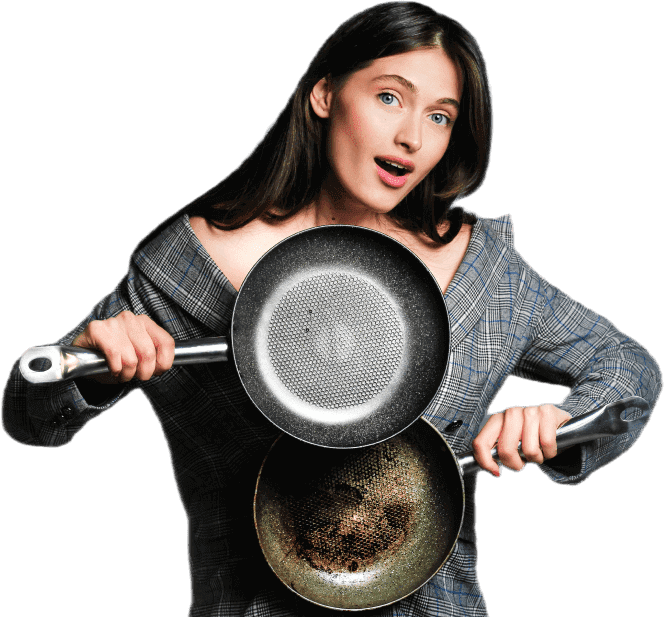Sharing the knowledge and useful information about the coatings!
What are non-stick coatings?
Non-stick coatings are special high-tech fluoropolymer PTFE coatings that allow food not to burn on frying, cooking and other metal surfaces. "Teflon" is a generic term for different polymer non-stick coatings with different performance characteristics, such as temperature, wear resistance, repulsion of liquids, etc. Non-stick coatings are special high-tech fluoropolymer PTFE coatings that allow food not to burn to frying, cooking and other metal surfaces.
"Teflon" is a generic term for different polymer non-stick coatings with different performance characteristics, such as temperature, wear resistance, repulsion of liquids, etc.
Show more
Hide
Do you restore non-stick coatings?
We use special sandblasting equipment to clean the work surface that is required for the product to work (frying pan, multi-cooker bowl, grill plate, etc.) and apply a completely new layer of non-stick coating with a thickness of at least 20 μm!
Show more
Hide
Is it safe?
The coatings that we use are manufactured in the EU and certified by the Ministry of Health of Ukraine to use in the food industry.
Show more
Hide
What is the lifespan of the coatings? What if they peel off in a week?
These non-stick coatings are similar to the coatings that you can find on pans, grills, and bowls of slow cookers that are sold on store shelves.
They have a high degree of adhesion (sticking to the metal surface).
We give a 6-month WARRANTY that the coating will not peel off!
Show more
Hide
What items are covered with non-stick coatings?
First of all, these are pans, grills, baking trays, slow cookers, waffle makers and other kitchenware that require non-sticking and non-burning of food and other products to the surface.
The coatings are used not only in the food industry, but also in other areas: molding press surfaces, heating elements, trays of conveyor lines, etc.
Show more
Hide
What is the completion time?
Items from 1 to 20 pieces are accepted for work for a period of 2 to 7 business days, the deadline for the orders with a bigger amount is negotiated separately.
Show more
Hide
Do you work only in Odessa?
At the moment, our manufacturing is located in Odessa, but thanks to Nova Poshta, we are able to fulfill orders throughout Ukraine!
Show more
Hide
Do I need to send you an entire waffle maker/multi-cooker/grill or just an item that needs to be coated?
We only accept the metal plates and items of electrical appliances that already have the handles taken down!
Show more
Hide
What affects the performance of non-stick coatings and how to extend their lifetime?
Fluoropolymer non-stick coatings that we use have excellent non-stick properties, operating temperature from -195 to +260 degrees ( +315 for a short time).
However, such coatings do not tolerate scratches with metal objects (knives, forks, thick brushes), highly caustic detergents, and lose their properties when overheated, as at a temperature higher than the working temperature, the process of physical destruction of the coating begins.
Show more
Hide
What types of coatings do you use?
We use "Teflon coating" and more wear-resistant coating called "Granite", as well as coating for industrial use Profi® XLR.
Show more
Hide
What are the dimensions of the items that may be coated?
At the moment, we are able to apply non-stick coatings on items with dimensions of 1000*1000 mm.
Show more
Hide
What metals are acceptable for coating?
We coat stainless steel, cast iron, aluminum and other metals!
Show more
Hide
Why after applying a new non-stick coating on the item, dents and hollow imprints appeared?
During the processing of the items, a sandblasting is carried out, as a result of which the contamination and remnants of failed Teflon coatings are completely removed from the surface.
After cleaning, small imprints may be visible, these are the consequences of metal corrosion caused by a long-term use of damaged old coating!
The non-stick coating that we apply is 20 to 40 microns thick and does not visually cover such defects, but it does not affect its operation and non-stick properties at all and will not affect the cooking process in any way!
Show more
Hide
Why did the color change and the external coating of the item peel off?
One of the stages of applying a new non-stick coating inside the cookware is the temperature treatment of the part both in our company and in Berghoff or Tefal.
Such conditions are provided by the technology.
There are a huge number of manufacturers of the kitchenware, and the exterior paint can be made of so many materials!
It is impossible to guess how they will react to heating.
Sometimes they retain their look, sometimes they change color, sometimes they peel off.
In order for the item to retain its aesthetic look, we recommend ordering an exterior coating additionally!
Show more
Hide
Why don't you do the coating on the outside bottom of the product?
We do not do so, because it is a contact surface. For technical reasons, it must remain open.
What do the numbers on my dishes mean?
Each product sent to Novaflon for restoration is assigned a number upon arrival. This is necessary for the restored dishes to return to the correct address.
Show more
Hide
Оцените данную страницу
На основании 12 отзывов. Оценка 4.53 из 5.



